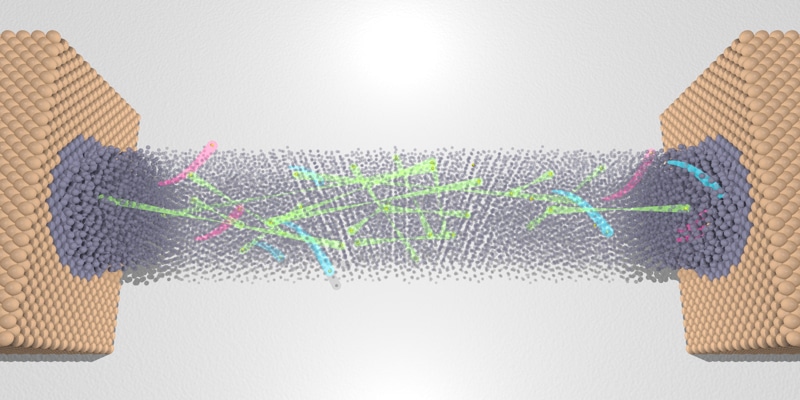Jul 11 2018
Cooling a wire to an extremely low temperature results in a breathtaking phenomenon where the electrons in charge of carrying the electrical current become paired and can flow endlessly without producing heat or slowing down.
 Electrons inside a wire about 10 nm thick can pair up at low temperatures (green) and become superconducting—they travel without resistance. However, in the presence of a magnetic field, the pairs deflect in opposite directions (pink and blue). (Image credit: Adrian Del Maestro)
Electrons inside a wire about 10 nm thick can pair up at low temperatures (green) and become superconducting—they travel without resistance. However, in the presence of a magnetic field, the pairs deflect in opposite directions (pink and blue). (Image credit: Adrian Del Maestro)
This fascinating phenomenon, called superconductivity, is highly significant to the magnetic resonance imaging machines used in hospitals and also large-scale particle colliders.
Certain metals behave as superconductors at higher temperatures, with significant ability for superconductor-based data processing and electric power transmission.
Yet, if the thickness of a wire was reduced by researchers down to the nanoscale size needed for advanced computer components—thinner than a human hair by millions of times—the transition to the superconducting state can vanish, “with the electrons stubbornly refusing to get along all the way down to absolute zero temperature,” stated Adrian Del Maestro, a UVM physicist.
At present, an innovative study, co-headed by Del Maestro and Andrey Rogachev, a physicist from University of Utah, shows the reason behind this.
The study has been reported in the Nature Physics journal on July 9, 2018, and is the first to reveal the microscopic process through which metal wires lose their superconductivity.
When the wire is sufficiently small, a magnetic field can disintegrate these electron pairs, known as Cooper pairs, which interact with other Cooper pairs and undergo a damping force from unpaired electrons that exist in the system. The small wire experiences a so-called quantum phase transition, transition from a superconductor to normal metal.
The ability to control this transition in nanowires could lead to a new class of energy efficient information technologies based on tiny superconductor.”
Adrian Del Maestro
In order to gain insights into phase transitions, one can analyze an iced drink on a hot summer day. Applying heat to observe the changes to its properties is a lesson in classical phase transitions.
At a critical point, it transitions from a liquid to a gas. By removing heat from the water by placing it in the freezer, its transformation to solid ice can be observed.
Consider cooling everything down to extremely low temperatures, very low that all thermal effects disappear. This is the quantum realm, where magnetic fields and pressure lead to the emergence of new phases in a phenomenon known as quantum phase transitions (QPT).
Superconductivity was discovered by researchers over a century ago, and high-temperature superconductors were discovered in the year 1986; however, the precise mechanism behind it is still obscure since the majority of materials are highly complex to understand the physical aspects in detail.
However, the researchers of the new study, headed by teams from the University of Utah and the University of Grenoble in France, could develop and test ultra-modern nanowires, with a thickness less than 10 nm, from a metal alloy known as molybdenum-germanium.
Using these nanowires, the researchers, with support from the National Science Foundation, could closely investigate how nanowires experience quantum phase transitions from a superconducting state to a normal metal state upon being placed in an increasing magnetic field at low temperatures.
The new laboratory findings are totally interpreted by the theory hypothesized by UVM’s Adrian Del Maestro. For the first time in the area of superconductivity, entire details related to a quantum phase transition proposed by a theory were confirmed using real objects in the lab.
Quantum phase transitions may sound really exotic, but they are observed in many systems, from the center of stars to the nucleus of atoms, and from magnets to insulators. By understanding quantum fluctuations in this simpler system, we can talk about every detail of the microscopic process and apply it to more complicated objects.”
Rogachev, Senior Author
Condensed matter physicists investigate the status of materials when all of their heat is removed in two ways—experimental physicists create materials to be tested in a lab, while theoretical physicists formulate mathematical equations to gain insights into their physical behavior.
This new study reported in Nature Physics describes the tale of how theory and experiment informed and motivated one another.
In Del Maestro’s “pair breaking” theory, it is improbable that single electrons will bump into the edges of the smallest wire as even a single strand of atoms is huge compared to the size of an electron.
However, Del Maestro stated, “two electrons that form the pairs responsible for superconductivity can be far apart and now the nanoscale size of the wire makes it more difficult for them to travel together.”
Subsequently, the addition of a powerful magnetic field, which disentangles pairs by curving their paths, leads to a scenario where “the electrons are unable to conspire to form the superconducting state,” stated Del Maestro.
Imagine that the edges of the wire and the magnetic field act like some frictional force that makes electrons not want to pair up as much. That physics should be universal.”
Adrian Del Maestro